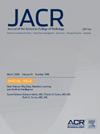远程医疗与现场就诊后影像利用的差异。
IF 5.1
3区 医学
Q1 RADIOLOGY, NUCLEAR MEDICINE & MEDICAL IMAGING
引用次数: 0
摘要
目的:2019冠状病毒病大流行导致远程医疗迅速扩张,但其对诊断成像利用的影响知之甚少。本研究在全国范围内评估远程医疗与面对面访问后成像利用的差异。方法:这是一项回顾性病例对照研究,使用来自Optum的去识别Clinformatics®数据集市数据库的数据。确定了2021年期间的远程医疗和亲自就诊,并根据各种就诊和患者特征进行了匹配。采用粗化的精确匹配权重加权多元线性模型,量化两种就诊类型在7天、14天和30天内就诊后影像学利用率和影像学研究次数的差异。结果:在23,431,032次就诊中,10%为远程医疗就诊。远程医疗就诊后7天的成像利用率低2.4个百分点(β = -2.37[95%置信区间:-2.41至-2.32]),与现场就诊相比,远程医疗就诊后的成像利用率低29.7%。14天和30天的结果相似。在就诊后进行影像学检查的患者中,远程医疗在就诊后7天内的影像学检查次数比现场就诊高0.02次(β = 0.021[95%可信区间:0.015-0.027])(相对差异为1.5%)。这种微小的差异贯穿了所有时期。结论:与匹配的现场就诊相比,远程医疗就诊与较低的成像利用率相关,表明这种设置可能不会促进成像增长。未来的研究应探讨在远程医疗访问中订购影像的适当性。本文章由计算机程序翻译,如有差异,请以英文原文为准。
Imaging Utilization Differences After Telemedicine Versus In-Person Visits
Purpose
The COVID-19 pandemic resulted in a rapid expansion of telemedicine, but little is known about its impact on diagnostic imaging utilization. This study evaluates differences in imaging utilization after telemedicine versus in-person visits at the national level.
Methods
This was a retrospective case-control study using data from Optum’s de-identified Clinformatics® Data Mart Database. Telemedicine and in-person visits during the year 2021 were identified and matched on various visit and patient characteristics. Weighted multivariate linear models with coarsened exact matching weights were estimated to quantify the differences in post-visit imaging utilization rates and number of imaging studies among visits with any post-visit imaging between the two visit types within 7 days, 14 days, and 30 days.
Results
Of 23,431,032 visits, 10% were telemedicine visits. The 7-day post-visit imaging utilization rate was 2.4 percentage points (β = −2.37 [95% confidence interval: −2.41 to −2.32]) lower among telemedicine visits, representing a 29.7% lower imaging utilization rate after a telemedicine visit compared with an in-person visit. Results were similar for the 14- and 30-day periods. Among the subset of visits with post-visit imaging, the number of imaging studies within 7 days after the visit was 0.02 (β = 0.021 [95% confidence interval: 0.015-0.027]) higher (1.5% relative difference) for telemedicine versus in-person visits. This small difference persisted across all periods.
Conclusions
Telemedicine visits were associated with lower imaging utilization compared with matched in-person office visits, indicating this setting may not contribute to imaging growth. Future studies should explore the appropriateness of imaging ordered during telemedicine visits.
求助全文
通过发布文献求助,成功后即可免费获取论文全文。
去求助
来源期刊

Journal of the American College of Radiology
RADIOLOGY, NUCLEAR MEDICINE & MEDICAL IMAGING-
CiteScore
6.30
自引率
8.90%
发文量
312
审稿时长
34 days
期刊介绍:
The official journal of the American College of Radiology, JACR informs its readers of timely, pertinent, and important topics affecting the practice of diagnostic radiologists, interventional radiologists, medical physicists, and radiation oncologists. In so doing, JACR improves their practices and helps optimize their role in the health care system. By providing a forum for informative, well-written articles on health policy, clinical practice, practice management, data science, and education, JACR engages readers in a dialogue that ultimately benefits patient care.
 求助内容:
求助内容: 应助结果提醒方式:
应助结果提醒方式:


